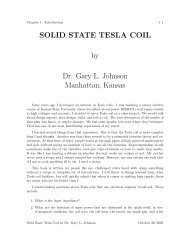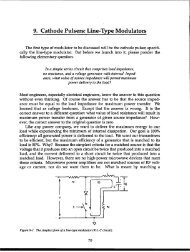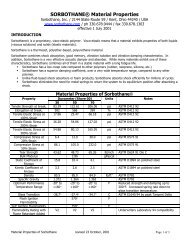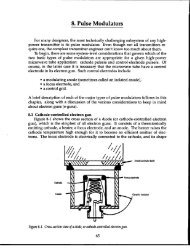3.6M north10.pdf - Dean-O's Toy Box
3.6M north10.pdf - Dean-O's Toy Box
3.6M north10.pdf - Dean-O's Toy Box
Create successful ePaper yourself
Turn your PDF publications into a flip-book with our unique Google optimized e-Paper software.
166 High-Power Microwave-Tube Transmitters<br />
higher the p factor will be, the higher the cathode-current-density change will be<br />
for a given grid-voltage change, and the greater the anode-voltage hold-off is<br />
likely to be. The wire-to-wire spacing of the grid, however, will have to be<br />
smaller, approximately equal to the spacing between grid and cathode. This is<br />
done so the “screening” effect of the grid, or the amount of total grid area that is<br />
physically blocked by the presence of grid wire, will be greater than that of a<br />
lower-p grid spaced farther away from the cathode. The greater the screening<br />
effect, the more likely the grid is to intercept electrons on their way from cathode<br />
to anode when the grid is driven positive with respect to the cathode. This<br />
screening effect is reduced if the diameter of the grid wire can be reduced. But<br />
the diameter must still be large enough to dissipate heat, including the heating<br />
caused by its proximity to the hot cathode and the interception of electrons.<br />
Even more importantly the wire must have cross-sectional area (or AWG gauge)<br />
sufficient to absorb the action content of an arc discharge without fusing. (As<br />
will be discussed later, the transmitter designer is responsible for limiting the arc<br />
action by employing surge-limiting resistance and, when needed, an electronic<br />
crowbar charge diverter.) Even in high-p tubes, the grid screening factor is less<br />
than 259’0, and it typically varies down to 109’o for low-p tubes. Grid current at<br />
anode-saturation voltage is typically 1.5 times the screening factor, so that a 2570-<br />
screened, high-p triode may intercept grid current that is 1.5 times 259’o, or 389’o,<br />
of cathode current, compared with 1.5 times 107o, or 15?40,for a low+. triode.<br />
Grids are almost always wound of tungsten or molybdenum wim that has<br />
been coated with gold or platinum. This is done so they can operate at temperatures<br />
higher than the cathode-even as high as 1400°C (compared to 1000”C for<br />
the cathode)—without becoming primary emitters of electrons themselves. When<br />
they are driven positive with respect to the cathode they will attract and intercept<br />
electrons. The sum total of these electrons constitutes grid current, and the<br />
product of this current and the peak-grid voltage is the peak-grid dissipation.<br />
This current and power must be supplied by the external grid-drive circuitry and<br />
must be dissipated by the grid as heat.<br />
Because of an effect called secondary emission, not all electrons that collide<br />
with the grid are counted as grid current, however. Primary electrons strike the<br />
grid surface and knock off others, which continue onto the anode. So long as the<br />
secondary emission is less than the primary interception, things look good for<br />
both the tube and driver. On the other hand, if more secondary electrons are<br />
emitted than primaries are collected, grid current is negative and the grid can run<br />
away, unless it is externally swamped by shunt resistance. Pulse stretching is the<br />
usual symptom of excessive secondary emission; cathode and plate currents continue<br />
even after the grid drive pulse has stopped. Pulse stretching in some<br />
thoriated-tungsten tubes can be corrected by a process called grid blackening. In<br />
this process, filament voltage is increased to twice its normal value (so filament<br />
power approximately trebles). Some of the filament carburization boils off and is<br />
deposited on the grid, making its surface stickier and less prone to secondary<br />
emission. Secondary emission is less likely from grid wires whose surfaces have<br />
been made intentionally rough, but anode-voltage hold-off is degraded as a consequence.<br />
Recently manufactures have made grids and screens of pyrolytic graphite.<br />
This material does not emit secondary electrons, but tubes using it do not always







